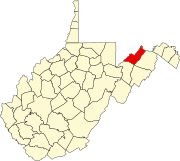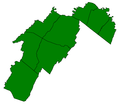Piedmont, West Virginia
Town of Piedmont, West Virginia | |
|---|---|
 Location of Piedmont in West Virginia | |
| Country | United States |
| State | West Virginia |
| County | Mineral |
| Area | |
| • Total | 0.4 sq mi (1.1 km2) |
| • Land | 0.4 sq mi (1.1 km2) |
| • Water | 0.0 sq mi (0 km2) |
| Elevation | 928 ft (283 m) |
| Population (2000) | |
| • Total | 1,094 |
| • Density | 2,414/sq mi (932.2/km2) |
| Time zone | UTC-5 (EST) |
| • Summer (DST) | UTC-4 (EDT) |
| ZIP code | 26750 |
| Area code | 304 |
| FIPS code | 54-63604Template:GR |
| GNIS feature ID | 1555341Template:GR |
Piedmont is a town in Mineral County, West Virginia, United States. It is part of the 'Cumberland, MD-WV Metropolitan Statistical Area'. The population was 1,014 at the 2000 census. Piedmont was chartered in 1856. The town is the subject of Colored People: A Memoir[1] by Piedmont native Henry Louis Gates, Jr.
Geography
As its name suggests, Piedmont is located at the base of a mountain, in this instance the foot of the Allegheny Front, the eastern edge of the Allegheny Mountains or Appalachian Plateau, on the south (West Virginia) side of the North Branch of the Potomac River.
Piedmont is located at 39°28′49″N 79°2′53″W / 39.48028°N 79.04806°W (39.480232, -79.048086)Template:GR. According to the United States Census Bureau, the town has a total area of 0.4 square miles (1.1 km²), all land.
History
The original main line of the Baltimore and Ohio (B&O) Railroad reached the site of Piedmont on July 21, 1851, and in 1853 connected Baltimore, Maryland, and the Ohio River at Wheeling, then (like Piedmont) in Virginia, and now in West Virginia. The line through Piedmont is still a major segment of the B&O system, now part of CSX Transportation.
The Town of Piedmont was chartered in 1856.
Piedmont was[when?] also known as Mount Carbon due to the persuasiveness of the officers of the New Creek Company,[citation needed] a corporation chartered to construct canals, build railroads, purchase lands, and carry on manufacturing. Corporate officials convinced the Baltimore and Ohio, the Burlington and Mount Holly Railroad, the Boston and Lowell, and the Long Island railroads to use coal instead of wood in the firing of their locomotives.[citation needed] The first coal used was mined in the mountains surrounding Piedmont.[citation needed]
During the American Civil War (1861-1865), the town of Piedmont was frequently raided by the McNeill's Rangers in an effort by the Confederates to disrupt B&O train service.
In 1888, William Luke established the West Virginia Paper Company (now NewPage Corporation) on 50 acres (20 ha) of Maryland land known as West Piedmont (now Luke, Maryland, adjacent to the larger town of Westernport, Maryland). The company remains a major economic factor in the area.
Jazz great Don Redman was born in Piedmont on July 29, 1900. Henry Louis Gates, a professor of African-American history at Harvard University, was raised in Piedmont, an experience he described in his 1994 book "Colored People".[1] Rock singer Steve Whiteman of the band Kix, best known for their hit song 'Don't Close Your Eyes', was born in Piedmont in 1956.
Demographics
As of the censusTemplate:GR of 2000, there were 1,094 people, 423 households, and 266 families residing in the town. The population density was 2,413.4 inhabitants per square mile (932.2/km²). There were 499 housing units at an average density of 1,187.7 per square mile (458.7/km²). The racial makeup of the town was 74.36% White, 21.79% African American, 0.20% Native American, 1.78% from other races, and 1.87% from two or more races. Hispanic or Latino of any race were 2.07% of the population.
There were 423 households out of which 29.3% had children under the age of 18 living with them, 38.1% were married couples living together, 20.1% had a female householder with no husband present, and 37.1% were non-families. 32.9% of all households were made up of individuals and 13.0% had someone living alone who was 65 years of age or older. The average household size was 2.40 and the average family size was 3.00.
In the town the population was spread out with 26.8% under the age of 18, 8.9% from 18 to 24, 28.6% from 25 to 44, 20.8% from 45 to 64, and 14.9% who were 65 years of age or older. The median age was 36 years. For every 100 females there were 89.9 males. For every 100 females age 18 and over, there were 88.8 males.
The median income for a household in the town was $21,190, and the median income for a family was $26,964. Males had a median income of $21,938 versus $18,250 for females. The per capita income for the town was $11,678. About 24.7% of families and 30.7% of the population were below the poverty line, including 41.3% of those under age 18 and 23.5% of those age 65 or over.


